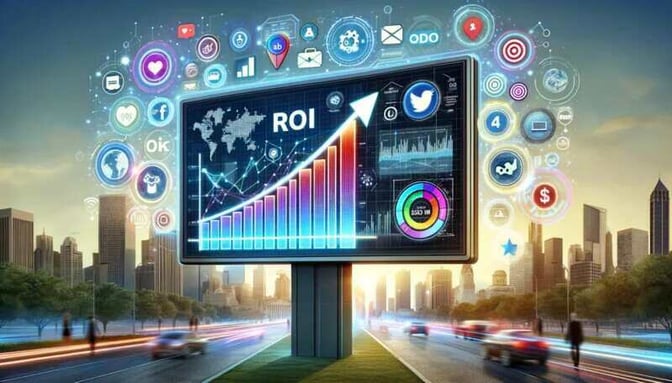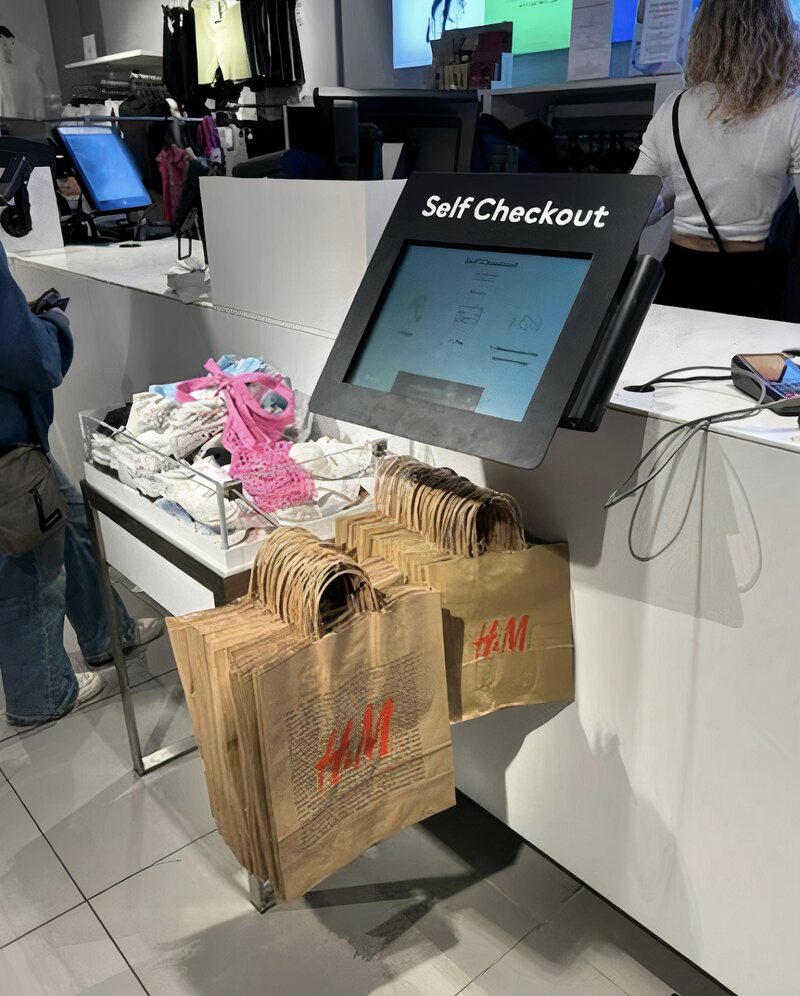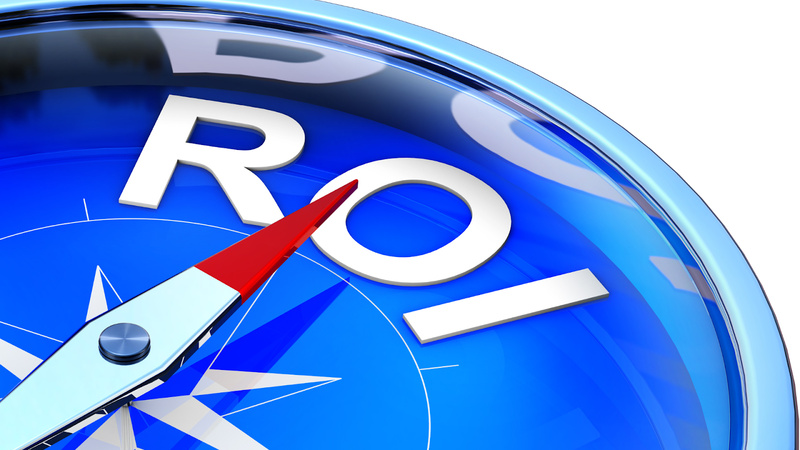Share this
Maximising ROI with Data-Driven Digital Signage
by Maria Georgieva on 21-Feb-2024

Table of Contents:
- What is Digital Signage?
- What is ROI and Why Is It Important?
- The Power of Digital Signage for Advertising
- Best Practices to Maximise ROI With Digital Signage
- Wrap Up
- FAQs
Today, many advanced technologies compete for consumer attention. A great number of business solutions aim to do greater, faster, and better. And we have to admit that digital signage, being on top of the wave, certainly leads the competition when it comes to engagement and retention rates.
It has become "the new standard" for businesses that want to establish a strong connection with their desired audience and deliver an unforgettable experience for each and every one of their loyal brand advocates.
The most impressive part of this medium is perhaps it is an undeniable benefit to grab pedestrians' attention with its high-quality image and creatives, especially in high-traffic areas. The best part is - this absolutely helps boost sales and returns on investment (ROI).
Now, you are probably wondering exactly how. You will find the answer to this and many other questions you may have if you stay with us until the end.
But first, let’s start with the basics!
What is Digital Signage?
We are sure you have seen flashy displays showing information or advertisements in stores while you were shopping for clothes for example. Or perhaps in restaurants while you were ordering food. In the theatre when you bought movie tickets. At the bus station or museums while you were looking for directions.
These displays are called digital signage and are used for informational or advertising purposes. Their dynamic nature captures the eye more effectively than static ads, for instance, and this makes them memorable, leaving a long-lasting impression on the customer.
In fact, the digital signage market has such an enormous impact and potential that it is expected to grow significantly by 2025. According to a report from Technavio Insights, the market will increase by $6.71 billion, with a growth momentum reaching a compound annual growth rate (CAGR) of 8.80%.
By these figures, you can see how the demand for and adoption of this medium are expanding across all kinds of sectors and industries.
What is ROI and Why Is It Important?
ROI or Return on Investment, is like checking how well your money did when you put it into something, like a business or a project. It helps you see if you made a good choice by telling you how much money you got back compared to what you spent.
How to Calculate It?

- Net Return on Investment
This is the money you earned from your investment after subtracting the amount you spent to make the investment. So, if you invested $100 and ended up with $120, your net return is $20.
- Cost of Investment
This is how much you originally spent on the investment. Using the same example, this would be the $100 you put in.
- The Division
You divide the net return ($20) by the cost of the investment ($100) to see how much you've made in comparison to what you spent.
- Multiply by 100%
This step turns the number you get from the division into a percentage, which makes it easier to understand. So if you divide 20 by 100, you will get 0.2. And when you multiply that by 100%, you will get 20%.
So the ROI tells you that for every dollar you spent, you made 20 cents on top of your original dollar. It is a quick way to see if your investment was worth it. If the ROI is a big number, you did well. If it is small or negative, the investment did not do so great.
Why Is It Important?
For a business owner who puts money into digital signage, ROI is the perfect tool to help you know if your signage is good for business. It is all about whether the money you spend on screens makes customers come in and buy things.
For example, you spend $1,000 on digital signage and it brings in $5,000 in sales. That is a good ROI. It means this advertising method works well for you to get more people to spend money.
On the other hand, if it does not bring enough extra sales to cover the cost of it, then the ROI is not so good, and you might think about trying something different in terms of strategy or content.
So you see why calculating return on investment is so significant and how it can help you make objective choices about how to spend your finances in order to grow your enterprise.
The Power of Digital Signage for Advertising
Digital signage is probably the best solution when it comes to advertising anything effectively. Do you think otherwise? Read on to see why this statement is true!
Leads to More Impulse Purchases and Foot Traffic
Digital signage can leave a serious impression on consumers, subconsciously leading them to enter a store or make impulse purchases.
Key statistics prove this point by highlighting that 80% of customers have reported choosing to enter stores after seeing colourful digital displays, and 76% of American consumers have stated they entered stores they had never visited before simply because of the signage.
For instance, you can further ensure impulse buys by strategically placing displays and relevant products near checkout areas.

Engages With the Consumer on a Different Level
This medium also sizably outperforms traditional paper advertising in terms of engaging your consumers. Analysis shows it garners 400% more views than static displays. Now, maybe you wonder why? Keep reading!
The psychology behind digital displays with moving images is actually quite fascinating. As humans, we are naturally attracted to movement. From an evolutionary standpoint, our survival often depended on noticing things in motion.
In today's world, where still images and static ads are prevalent, a moving display catches our attention because it is different and our brains are naturally wired to notice this difference.
Once digital signage has caught our attention, it can keep us engaged through a few different ways:
- Novelty
Moving images often feel new and exciting, and our brains are curious about new things.
- Storytelling
Movement can tell a story, even in a short loop. We are drawn to stories because they are how we make sense of the world.
- Memory
When we see something that engages our emotions or tells a story, we are more likely to remember it.
- Expectation of Information
Upon seeing movement, we frequently expect receiving information. In a digital display, this movement might lead us to anticipate important news or deals, leading us to pause and take notice.
- Sensory Engagement
Moving images can engage more of our senses than static ones. They can create an illusion of sound and touch, which makes the experience more immersive.
Digital displays use these psychological tricks to make us stop and stare, which gives the message they are showing a better chance to sink in and influence our behaviour, like making us want to buy something or remember a brand.
Saves You Time and Resources
Thanks to digital signage, you can update the information you want to display in real-time anytime and no matter where you are. It helps you manage your displays remotely without even sweating it!
For example, imagine you own a store. You add 100 new products and need to change the prices of 100 more old ones. Picture actually having to print 100 posters and spinning the entire store to place them in the relevant areas, or even worse - manually adjusting the price of 100 different products.
Our point is - signage is a fantastic medium to help you optimise these retail processes. All of the above examples can be done effortlessly, quickly, and way more pleasantly for you and your employees!
Best Practices to Maximise ROI with Digital Signage
Congratulations, you have made it to the heart of this article! Below, we will walk you through everything you need to know in terms of the best practices to maximise your ROI with digital signage.

1. Understanding and Implementing A/B testing
A/B testing is essentially a strategy where you compare two versions of something to see which one performs better. When you apply this to digital signage, you are checking which design—be it the layout, the message, or the visuals—grabs the attention of customers more effectively.
In the realm of data-driven marketing, this approach fosters continuous experimentation and fine-tuning. The insights you gain from this testing allow you to identify the "winning" strategy and elements, so you can refine your approach and make it more accurate for your customers.
This method heavily relies on actual data to guide decisions, cutting out the guesswork and ensuring your marketing is constantly improving and performing at its best.
2. Constantly Monitoring Your Content Strategy
Bill Gates, Microsoft founder, said “Content is king.” And we can see how this is true. Imagine a website or an ad with a great layout and visuals but no text. How do you know what it is trying to tell you? Or what it is trying to sell? What is its value?
Well without words - you simply do not know. Content holds a crucial place in communication because it is the key to understanding the message that a business is trying to convey.
Text, or content in general, is what tells the story. Without it, all those visuals do not have context. It is the words that explain, persuade and connect with the audience. They give meaning and value to the graphics and make the purpose of the website or ad clear.
However, successful marketing campaigns continue beyond simply having a piece of content. You also need to monitor and update these materials constantly in order to keep them relevant to your audience. What works today might not resonate with your customers tomorrow.
Trends, user preferences and the competitive landscape are known to change rapidly. so you need to keep an eye on your content to ensure it stays fresh, accurate and engaging.
3. Using Location-Based Targeting
Another key ROI strategy is considering the employment of location-based targeting. You can place digital displays in optimal spots by pinpointing areas with high foot traffic and understanding the specific demographics of your intended audience.
This way, you can ensure the ads you selected will be seen by the most relevant consumers when they are most likely to be influenced, i.e. targeting the right people at the right time.
Additionally, tailoring content to match the interests and needs of the local demographic can further amplify the effectiveness of your efforts.
4. Make Decisions Based on Data
Using data and analytics (to track metrics such as impressions, viewer engagement, conversion rates, and dwell time) is also vital for making your digital signage ads better. By gathering and looking at data on how consumers act, enterprises can understand how well their signage performs.
This will let them make smart choices to boost the performance of their campaigns. If you want to make the most out of your investments and reach as many relevant people as possible, keep in mind checking if and how your consumers interact with your ads and if they actually lead to sales.
5. Choose the Right Hardware and Software
Choosing the most suitable hardware and software for your needs directly impacts the digital signage solution's performance, reliability, and effectiveness.
What you will need to consider is the display size and resolution, media player and content management system (CMS), connectivity, and, most importantly - security features.
For example, digital signs meant for outdoor settings need to be resistant to all kinds of drastic weather and bright enough to see clearly in the sun. Also, the media players should be powerful and have enough space to run the software without issues.
Moreover, selecting top-notch hardware from well-known brands, like Samsung, can make the digital signage system last longer. This lowers the overall costs over time and increases the return on investment (ROI).
For instance, MagicINFO - a software specifically designed for Samsung hardware, is a fully secured digital signage solution that meets all these requirements and lets you remotely manage the content displayed on your screens.
Wrap Up
We walked you through everything we believe is essential to know for everyone utilising digital signage. We hope this article helped you better understand the importance of measuring ROI and how to implement signage in your business strategically!
Remember to visit our blog for more amazing articles to guide you through your digital signage journey!
Frequently Asked Questions
1. What makes digital signage a better choice than traditional signs?
Digital signage stands out because it uses advanced screens to show videos, images, and updates that can change in real time. The psychology behind digital displays with moving images is that as humans, we are naturally attracted to movement. A moving display catches our attention because it simply stands out; it is different, and our brains are wired to notice that difference.
2. Why is Measuring ROI Important for Digital Signage?
Measuring ROI helps businesses understand the value of their digital signage by comparing the costs against the benefits, like increased sales or more customer visits. A strong ROI shows that the digital signs are effectively drawing attention and encouraging people to act, proving the investment worthwhile.
3. How Can I Make My Digital Signage More Effective?
To make your digital signage work better, try different things to see what catches people's attention the most, like changing the design or message. Also, always check what's working by looking at data, like how many people looked at your sign and then bought something. Make sure your digital signs are placed where lots of people can see them too, especially those who might be interested in what you're selling.
No Comments Yet
Let us know what you think